THANK YOU TO OUR PARTNERS



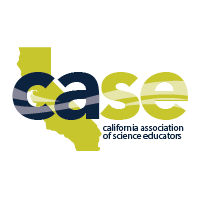
REGISTRATION IS CLOSED FOR HIGH SCHOOL VIRTUAL LEARNING SEQUENCE WEBINARS
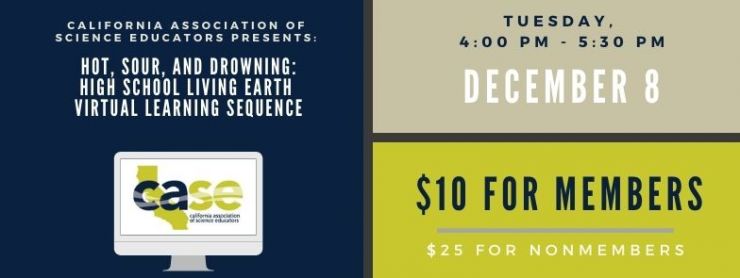
Hot, Sour, and Drowning: High School Living Earth Virtual Learning Sequence
Date: Tuesday, December 8, 2020 | Time: 4:00 pm - 5:30 pm (Pacific)
Fee (Non-Refundable): $10/Member or $25/Nonmember
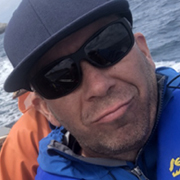
This webinar focuses on the release of a designed-for-NGSS learning sequence built by CA teachers and scientists that explores the impacts of temperature change on corals through case study analysis. Participants will dig into understanding the data of temperature change at coral reef locations around the globe. Participants will then look at how those changes on a global scale affect coral and human communities locally. We will look at using “slices” of practices such as developing and building models (of coral communities), engaging in argument from evidence (with our models) and obtaining, evaluating and communicating information (to groups that have impact).
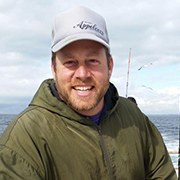
The sequence has been updated for delivery through online or hybrid platforms to reflect the current teaching situations many of us face.
Participants will end the webinar with resources they can use in their own classrooms, some new tools and strategies that can be adapted for other lessons, and a stronger background in the science behind climate impacts on populations.
Presenters:
Jeremy Long, Professor, San Diego State University (top right)
Matthew Leader, Math/Science Teacher, High Tech High (bottom right)
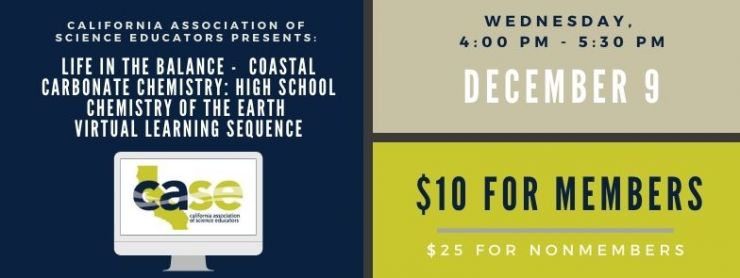
Life in the Balance - Coastal Carbonate Chemistry: High School Chemistry of the Earth Virtual Learning Sequence
Date: Wednesday, December 9, 2020 | Time: 4:00 pm - 5:30 pm (Pacific)
Fee (Non-Refundable): $10/Member or $25/Nonmember
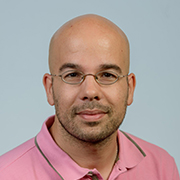
This webinar focuses on the release of a designed-for-NGSS learning sequence built by CA teachers and scientists developed to support students in the sensemaking process with the anchoring phenomenon of Oyster Die-Offs along the Pacific Coast. This topic is addressed, not just as a question of science but also a question of equity as the groups who are responsible for ocean acidification are not always those who must deal with its consequences.
The sequence has been updated for delivery through online or hybrid platforms to reflect the current teaching situations many of us face.
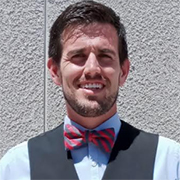
Participants will end the webinar with resources they can use in their own classrooms, some new tools and strategies that can be adapted for other lessons, and a stronger background in the science behind ocean acidification.
Presenters:
Mathieu Richaud, Associate Professor, California State University, Fresno (top right)
Robert Terrill, Chemistry and Physics Teacher, San Marcos High School (bottom right)
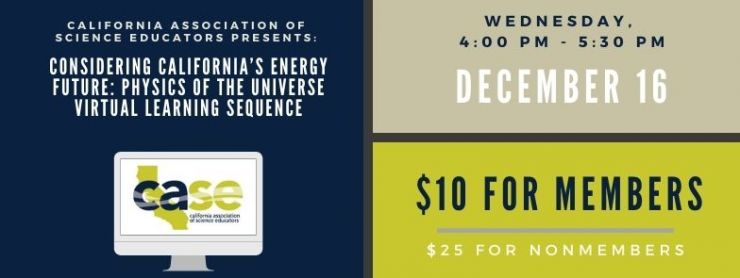
Considering California’s Energy Future: Physics of the Universe Virtual Learning Sequence
Date: Wednesday, December 16, 2020 | Time: 4:00 pm - 5:30 pm (Pacific)
Fee (Non-Refundable): $10/Member or $25/Nonmembers
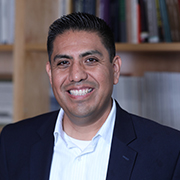
This webinar focuses on the release of a designed-for-NGSS learning sequence built by CA teachers and scientists developed to support students in making observations of the poorest air quality in their own backyards and find out that the worst air quality is inequitable within urban areas. Students use data to determine the causes and solutions for the poor air quality and design solutions based on Governor Brown’s Initiative to convert California to 100% Renewable Energy for electricity by 2045. Students include data from COVID-19 reductions in human activity and emissions to support the claim that humans are causing poor air quality which is impacting the environment, prompting the need for decreasing our carbon footprint.
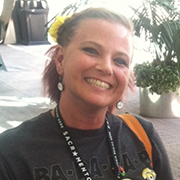
The sequence has been updated for delivery through online or hybrid platforms to reflect the current teaching situations many of us face.
Participants will end the webinar with resources they can use in their own classrooms, some new tools and strategies that can be adapted for other lessons, and a stronger background in the science behind impacts of energy use.
Presenters:
Alfredo Martinez-Morales, Managing Director & Research Professor, Southern California Research Initiative for Solar Energy, University of California, Riverside (top right)
Melissa Marcucci, Physics Teacher, Ceres High School (bottom right)
